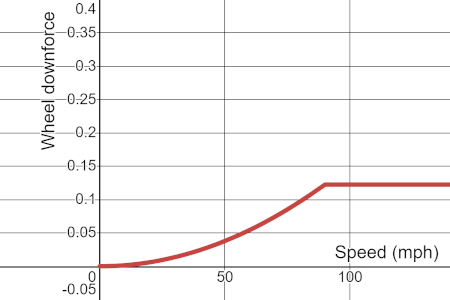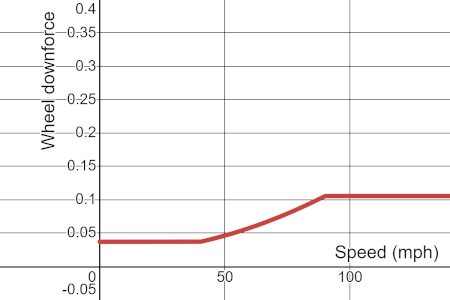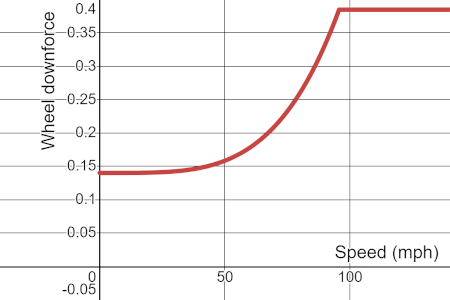Downforce Mechanics in GTA Online
This page details the effects of spoiler upgrades and downforce mechanics that affect a car’s grip level in GTA Online. This video is also an option for a more simplified explanation with visual aids.
Written by: Adam10603, Nismo, and Chilli
How Downforce Works In GTA 5
Air moving over a car in real life produces a downwards force that gives the car more traction, and GTA 5 simulates this as well. As a baseline, there’s a natural downforce in the game that affects all cars. This is the reason cars are visibly pushed down at higher speeds.
Besides natural downforce, there’s also a value calculated in real-time as a part of the driving physics code, and it can be observed with tools like Cheat Engine. Technically it affects the suspension, but for simplicity we are calling it wheel downforce. Each wheel on a car has its own instance of this value. Working together with natural downforce, wheel downforce determines the final downforce that the wheel experiences. Higher values push the wheel more against the ground, giving it more traction. All cars in the game have this.
While natural downforce is constant, spoilers and downforce modifiers affect wheel downforce in different ways, and this is the reason they affect the car’s grip.
Types of Downforce Mechanics
Currently all cars in GTA Online are one of five types. Each type behaves differently and will cause spoilers and downforce modifiers to have different effects on wheel downforce.
- Regular mechanics
- Cars with no fDownforceModifier in the handling file. Most cars are like this.
- Old-style downforce mechanics
- fDownforceModifier ≤ 100. First added in the Cunning Stunts DLC.
- New-style downforce mechanics
- fDownforceModifier > 100. First added in the Doomsday Heist DLC.
- Open wheel downforce mechanics
- The “Open wheel behavior” flag set in strAdvancedFlags. More about this later.
- Active spoiler mechanics
- Cars with an active spoiler. This will be discussed separately from the rest.
Underlying Math
The equations in this section aren’t fully detailed as this is just meant to show their basic logic, and certain values have been rounded for convenience as well. To see the full formulas with exact values, look at the Interactive Calculators section.
Wheel downforce will be abbreviated as WDV from this point, and “top speed” refers to fInitialDriveMaxFlatVel in the handling data, which is in km/h (the graphs are converted to mph).
Regular Mechanics
- No / stock spoiler
- WDV has a flat value of 0.035 regardless of speed.
- Custom spoiler
- WDV has a flat value of 0.07 regardless of speed.
Regular vehicle with no spoiler upgrade
Old-style Downforce Mechanics
- No / stock spoiler
- WDV is 0.0 when standing still.
- WDV keeps increasing until 90% top speed, exponentially.
- WDV has a cap of
fDownforceModifier × 0.035at > 90% top speed.
- Custom spoiler
- Same as no spoiler, but the final WDV value is multiplied by 1.25.
- Note: fDownforceModifier ≤ 1.0 will stop WDV from being calculated dynamically. This means that the car will behave as if it had Regular Mechanics.
RE-7B (fDownforceModifier = 3.5) with no spoiler upgrade
New-style Downforce Mechanics
- No / stock spoiler
- WDV has a flat value of
(fDownforceModifier ÷ 100) × 0.035 × 0.3at ≤ 40% top speed. - WDV keeps increasing between 40% and 90% top speed, exponentially.
- WDV has a cap of
(fDownforceModifier ÷ 100) × 0.035 × 0.86at > 90% top speed.
- WDV has a flat value of
- Custom spoiler
- Same as no spoiler, but the final WDV value is multiplied by 1.25.
- Note: This is the only type that behaves differently in Single Player. The game deliberately skips calculating this type of downforce in SP, resulting in a flat fallback WDV value.
Emerus (fDownforceModifier = 350) with no spoiler upgrade
Open Wheel Downforce Mechanics
- No / stock spoiler
- WDV is
(fDownforceModifier × 0.07 × 0.3) + 0.035when standing still. - WDV keeps increasing until 95% top speed, highly exponentially.
- WDV has a cap of
(fDownforceModifier × 0.07 × 1) + 0.035at > 95% top speed.
- WDV is
- Custom wings
- Each wing has a unique modifier value in the handling file (stock wings are 1.0). Applying a wing will multiply fDownforceModifier by the wing’s modifier before the above formulas are calculated. Front wing upgrades only affect calculations on the front wheels, and rear wings only affect the rear wheels.
- If a wing breaks off, fDownforceModifier is divided by 5 for the affected wheel pair. However, the broken wing’s multiplier is still taken into account as well.
PR4 (fDownforceModifier = 5.0) with no wing upgrades
Active Spoilers
Certain cars in the game have active spoilers, and these also have an effect on wheel downforce. Active spoilers always override regular spoiler upgrades and downforce modifier values. This means that cars with an active spoiler that also have spoiler upgrades (like the X80 Proto), or have an fDownforceModifier value (like the Itali RSX) are unaffected by those things.
The way active spoilers behave can be broken down into two categories:
Normal Active Spoilers
This is the default behavior of active spoilers (found on the T20, Furia, Ignus, and Itali GTO Stinger TT). Essentially the effect is identical to a spoiler upgrade on a regular car, but only when the active spoiler is raised.
- Spoiler lowered
- WDV is 0.035 (like a regular car with no spoiler).
- Spoiler raised
- WDV is 0.07 (like a regular car with a custom spoiler).
- The change in WDV is matched to the animation of the spoiler being raised and lowered, so the transition is gradual.
- Despite any animation to suggest so, this type of active spoiler does not have any additional effects during braking or cornering.
- Note: add-on or modded vehicles with an active spoiler will also work in this way by default.
Special Cases
These vehicles use special rulesets instead of the default behavior seen above.
- Nero
- Same as the default behavior, but WDV is 0.07625 when the spoiler is raised.
- XA-21, Virtue
- Same as the default behavior, but WDV is 0.075 when the spoiler is raised.
- Hotring Hellfire
- Spoiler behaviour is attached to the roof flaps which activate under braking. WDV is 0.229 when those flaps are raised.
- X80 Proto
- Going straight
- Same as the default behavior, but WDV is 0.042 when the spoiler is raised.
- Turning or braking
- WDV can increase to 0.07 when at least one of the active flaps is at its maximum angle.
- Note: add-on or modded vehicles that make use of the same type of active flaps as the X80 Proto also work in this way.
- Going straight
- Comet S2, Comet S2 Cabrio, Itali RSX, Omnis e-GT, Torero XO, 10F, 10F Widebody
- These have active spoilers that force a constant wheel downforce of 0.035. They are permanently stuck in a state equivalent to a regular car with no spoiler upgrade.
Open Wheel Behavior Flag
This is a flag that can be enabled in the strAdvancedFlags field in the handling files. Its value as a bit-shift expression is 1 << 27 or 8000000 in hex. The flag was added to the game in The Diamond Casino Heist update, and it’s only found on open wheel race cars (hence the name).
When applied to a car, it switches the downforce behavior to the open wheel type explained above, and it also prevents any speed gain from mechanics such as curb boosting.
If the flag is applied to a vehicle that doesn’t have the special wing upgrades of an open wheel car, the resulting downforce behavior is equivalent to an open wheeler with broken off stock wings.
For more info on how these flags work and are applied, read the Handling Flags page of this site.
Interactive Calculators
Below are links to interactive tools you can use to graph the wheel downforce behavior of any car, given some basic input parameters.
The math for these calculations was taken directly from disassembled game code. Apart from some rearranging to make things work better in the graphing tool, the formulas are mathematically identical to how the game calculates wheel downforce values.



